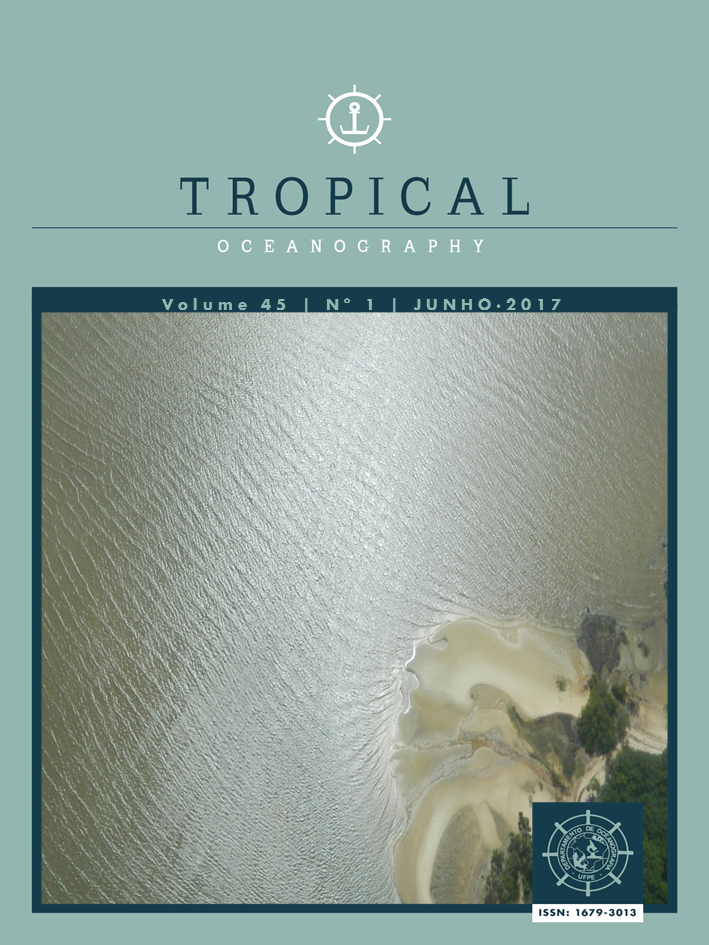The M2 And M4 Tides in the Pará River Estuary
DOI:
https://doi.org/10.5914/tropocean.v45i1.15198Palavras-chave:
, Tidal distortion, Tidal asymmetry, Tidal components, Lateral variations.Resumo
The Pará River estuary is a complex and special system in amazon continental shelf, with micro and mesoscale physical processes generated by forces of different sources (e.g., astronomical tides and river discharge). In this study, the main semidiurnal (M2) and the overtide (M4) components were analyzed by quantifying distortions degrees and identifying tidal asymmetries in the Pará River estuary. Two submersible tidal gauges were moored to measure the water level. One on the right margin (point #RG) and another on the left margin (#LF) recorded measurements 6 months (from September 2014 to March 2015). Furthermore, we used harmonic charts from Marine Studies Foundation (FEMAR, Fundação de Estudos do Mar). Lateral variations were also identified between #RG and #LF points from the amplitude and phase cotidal charts, with about 10 minutes delay and variation of 2 cm in tidal amplitude. We verified that the tidal wave enters in system by the right margin (#RF). The results show distortion degrees higher than 10% and positive asymmetry of the tidal wave in the Pará River, and the tidal attenuation in the estuary may be greater than 400 km upstream along the drainage basin.
Referências
Baltazar, L.R.S.,Menezes, M.O.B. andRollnic, M.(2011),Contributions to the understanding of physical oceanographic processes of the Marajó Bay -PA, North Brazil,Journal of Coastal Research,Vol. 64, pp. 1443-1447.
Beardsley, R.C.,Candela, J.,Limeburner, R.,Geyer, W.R., Lentz, S.J., Castro, B.M., Cacchione, D. andCarneiro, N.(1995), The M2tide on the Amazon shelf,Journal ofGeophysical Research: Oceans, Vol. 100, IssueC2, pp. 2283–2319.
Bezerra, M.O.,Medeiros, C., Krelling, A.P.M., Rosário R.P. andRollnic, M.(2011),Physical oceanographic behavior at the Guama/Acara-Moju and the Paracauari river mouths, Amazon coast (Brazil),Journal ofCoastal Research, Special Issue64,pp. 1448-1452.
Callède, J., Cochonneau, G., Ronchail, J., Alvez, F.V., Guyot, J.L., Guimares, V.S. and de Oliveira, E.(2010),Les apports en eau del’Amazone a l’ocean Atlantique,Revue des Sciences de L’Eau, Vol. 23, No. 2, pp. 247-273.
Cárceres, M., Valle-Levinson, A. andAtkinson, L.(2003),Observations of cross-channel structure of flow in an energetic tidal channel,Journal of Geophysical Research: Oceans, Vol. 108, IssueC4, pp. 2156-2202.
Cartwright, D.E.(1967),Time-series analysis of tides and similar motions of the sea surface,Journal ofApplied Probability, Vol. 4, pp. 103–112.
Dai, A.andTrenberth, K.E.(2002),Estimates of freshwater discharge from continents: latitudinal and seasonal variations,Journalof Hydrometeorology,Vol. 3, No. 6, pp. 660–687.
Defant, A.(1961),Physical oceanography, VI. Pergamon Press, New York.
Emery, W.F. and Thomson, R.E. (1998), A data analysis methods in physical oceanography. Elsevier, 400p.
Fundação de Estudos do Mar, Brazil(FEMAR) (2000),Catálogo de EstacõesMaregráficas Brasileiras,FEMAR (eds), available at http://fundacaofemar.org.br/portalwordpress/(acessed27 November 12).
Friedrichs, C.T. andAubrey, D.G.(1988),Non-linear tidal distortion in shallow well-mixed estuaries: a synthesis,Estuarine,CoastalandShelf Science,Vol. 27, pp. 521–545.
Gabioux, M., Vinzon, S. and Paiva, A.M.(2005),Tidal propagation over fluid mud layers on Amazon shelf,ContinentalShelf Research,Vol. 25, pp. 113–125.
Gallo, M.N. and Vinzon, S.B.(2005),Generation of overtides and compound tides in Amazon estuary. Ocean Dynamics,Vol. 55, No. 5–6, pp. 441–448.
George, K.L.(1995),Tides for marine studies.Secondedition,University of Plymouth,Institute of Marine Science, 180p.
Gregório, A.M.S.and Mendes, A.C.(2009), Characterization of sedimentary deposits at the confluence of two tributaries of the Pará river estuary (Guarajá bay, Amazon),Continental Shelf Research,Vol. 29, pp. 609–618.
Harris, D.L. (1981), Tides and tidal datums in the United States,U.S. Army Coastal Engineering Research Center, Special Report No.7, Ft. Belvoir, VA.
Kjerfve, B.(1990),Manual for investigation of hydrological processes in mangroveecosystems, Paris, UNESCO/UNDP, 79 p.
Le Bars, Y.L., Lyard, F.,Jeandel, C. andDardengo, L.(2010),The AMANDES tidal model for the Amazon estuary and shelf,Ocean Modelling, Vol. 31, pp. 132-149.
Li, C. and O’Donnell, J. (1997),Tidally driven residual circulation in shallow estuaries with lateral depth variation,Journal of Geophysical Research: Oceans, Vol. 102, Issue C13, pp. 915-929.
Macmillan, D.H.(1966),Tides,Elsevier, New York.
Masson, S. andDelecluse, P.(2001),Influence of the Amazon river runoff on the tropical Atlantic,Physics andChemistry of theEarth, Vol. 26, No. 2, pp. 137-142.
Miranda, L.B.,Castro, B.M. andKjerfve, B.(2002),Princípios de Oceanografia Física em Estuários,2ª edição,EDUSP, São Paulo, 426 p.
Richey, J.E., Nobre, C. and Desser, C.(1989), Amazon River discharge and climate variability: 1903-1985,Science, Vol. 246, pp. 101-103.
Oltman, R.E.(1968),Reconnaissance investigations of the discharge and water quality of the Amazon River,U. S. GeologicalSurvey, Circ. 552, 16 p.
Parker, BB.(1991),The relative importance of the various non-linear mechanisms in a wide range of tidal interactions (review), in Parker, BB.(Ed.),Tidal Hydrodynamics, John Wiley, New York, pp. 237–268.
Pawlowicz, R., Beardsley, B. andLentz, S.(2002),Classical tidal harmonic analysis including error estimates in MATLAB using T_TIDE,Computers &Geosciences, Vol. 28, pp. 929–937.
Prestes, Y.O., Rollnic, M., Silva, M.S. andRosário, R.P.(2014),Volume transport in the tidal limit of the Pará River, Brazil,Proceedings of the 17th Physics of Estuaries and Coastal Seas conference, Porto de Galinhas, Pernambuco, Brazil.
Prestes, Y.O.(2016),Interações físicas entre o estuário do Rio Pará e a plataforma continental no norte do Brasil,MSc Thesis, Federal University of Pernambuco, Recife, Brazil.
Pugh, D.T.(1987),Tides: surges and mean sea level, John Wiley, New York.
Rosário, R.P.,Rollnic, M.and Santos, A.S.(2014),Contributionto understanding the surface seawater intrusion in the Pará River estuary during low discharge,Proceedings of the 17th Physics of Estuaries and Coastal Seas Conference, Porto de Galinhas, Pernambuco, Brazil.
Speer, P.E.andAubrey, D.G.(1985),A study of non-linear tidal propagation in shallow inlet/estuarine systems, II: Theory,Estuarine andCoastal Shelf Science, Vol. 21, pp. 207–224.
Valle-Levinson, A.andLi, C. (2000), Convergence of lateral flow along a coastal plain estuary,Journal of Coastal Research,Vol. 105, Issue C7, pp. 17045-17061.

